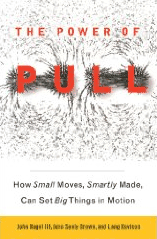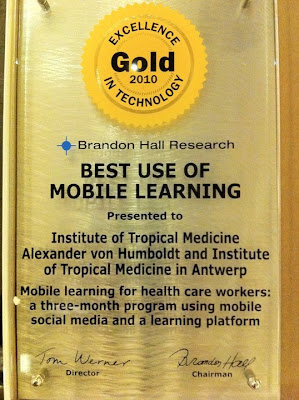 John Seely Brown
John Seely Brown a gray-bearded man with glasses and wearing a blue shirt and blazer. He just wrote another book called "
The power of pull". together with John Hagel III and Lang Davison.
Learning demand and the art of life.
The old institutions are not hacking it too well, something has to give. So we need to know where we are coming from, to understand where we should be going.
He starts with a historical view starting with Alfred Chandler who spoke on Push economy. One fundamental idea: look for scalable efficiency. => the more you do something, the better you get at it. This method was more or less authority guided.
The scalable efficiency curve drives us to keep on going, to move forward at an increasing pace.
Today we are undergoing a fundamental change, leading us to the new face of learning.
S-curve: something is introduced (slow evolution), something is picked up (fast evolution), something is adopted and continuous (slow evolution). But currently, there are new things popping up continuously, restarting an S-curve every-time, increasing the needed adoption speed.
this results in the need to relearn, again and again, in every professional domain.
This fact is undermining current education, for the world is ever changing. This constant change, the half age of any given skill is now reduced to 4 to 5 years.
The big shift: how do we move from stocks of knowledge (knowledge assets), to a world that is ever changing => participation becomes central, which redefines learning and creation. We move from stocks to flows (participating in knowledge flows).
How do you immerse yourself in the context to find the patterns that matter?
It is the big shift, the move from Push to Pull.
So we are at a crisis of Imagination: what can these technologies do, that we did not do before?
Next to this shift, we have an explosion of data at the moment. Every two days we create as much information as we did from the dawn of age up until 2003.
this challenges our thoughts on how we learn. We need to create a resilient mindset. The importance of the tacit becomes more important (that of which we have only a limited notion, needs to be materialized to make it knowledge that can be taught).
So how do we create a new mindset, that does not run from change, but embraces it (remark from myself: is not this counter human, will we be able to counter Roger's curve?).
Talks about a fortuitous encounter: Maui has never produced champion surfers, all of the prize surfers come from Hawaii. But Dusti Paine, from Maui, wanted to become a hardcore, professional surfer. Dusti searched for peer surfers, to create competition and collaboration to learn from each other, to become the best. It worked, and he became a world champion surfer. What makes this story incredible, is that ALL 5 are now world champion surfers. They looked at all possible surfing video's and tried and learned. Then they recorded themselves, deconstructed each others moves frame by frame... They also move to all the hot-spots, they put up 'bakens' where all surfers can come and share their experiences and moves.
This strengthening by collaboration and competition is true for social media use. Which is also being prepared to fail, time and time again. And today peers learn from each other at an ever increasing pace. And... we all become part of it. It becomes our world.
This is the passionate pursuit of the extreme performance with a deep questing disposition. This is what we all need to acquire or grow.
We must learn to learn from others, to collectively indwell in actions, and to reflect upon it afterward with all the others. Marinating together in a problem space with joint action.
We must learn to step beyond the cognitive, we must transcend cognition (remark from me, well... it is possible when patterns are embedded in the mind by repetition, which allows them to know without consciously knowing. But can we - as adults - embed patterns? or can this only be done with young minds?).
Self-organization is taking place with learners from gaming communities. People gather information from an amazing amount of sites and media, then process it into useful knowledge.
We must learn to open up for serendipity, to get out of our own comfort zone. How much will you expose yourself to, considering stuff you never saw before. We must learn to spend time out of our comfort zones (yes, this would be like following any multi learner course (e.g. PLENK).
Ends with two simple observations: the Red Queen effect (we go faster and faster, but still we fall back more and more. So we need to harness network effects, to dig deeply into learning). Secondly, we must achieve scalable capability building for firms, for institutes. We must learn from others as they learn from us (at best :-) . We must accelerate bootstrapping in a learning ecosystem.


